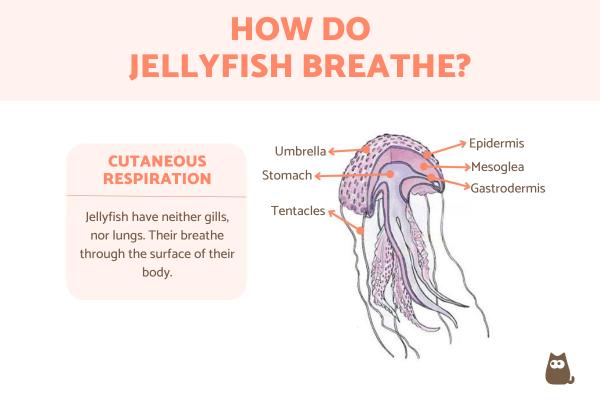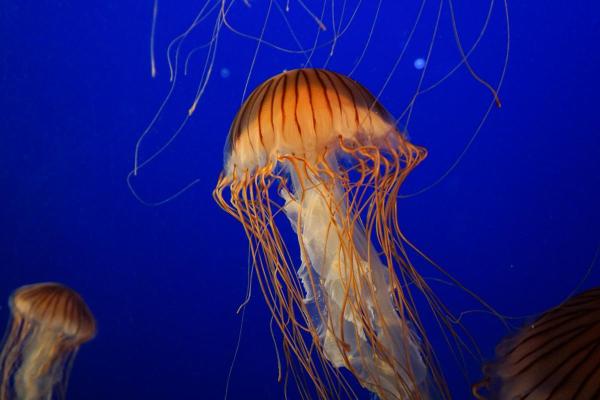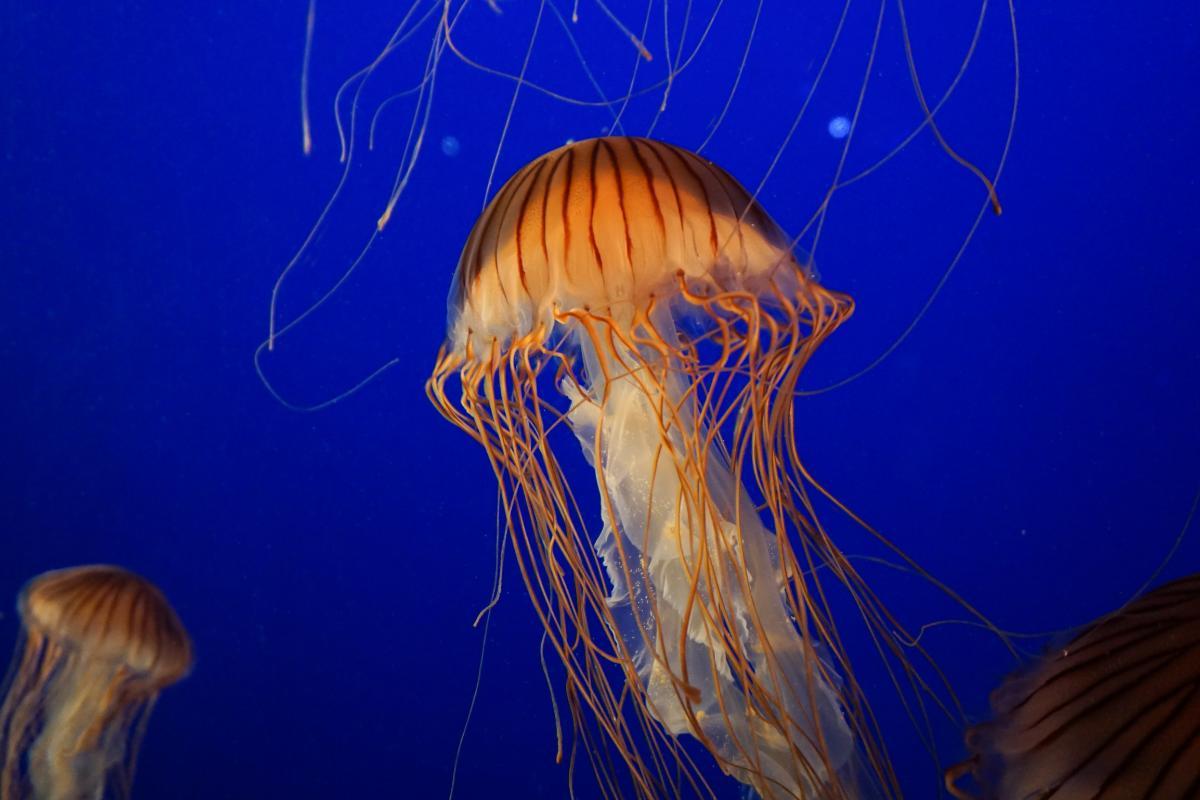How Do Jellyfish Breathe?


Jellyfish have a unique morphology, with a body that resembles few others in the animal kingdom. Despite this appearance, they carry out the same necessary functions and behaviors as all living things. They feed, reproduce and even respire. Respiration in jellyfish is possible thanks to their specially adapted bodies which allows them to take oxygen from their environment. Although they have the word ‘fish’ in their name, jellyfish are not actually a type of fish. They are organisms belonging to the phylum Cnidaria. This means they do not have gills like fish do, necessitating other ways to breathe in the water.
At AnimalWised, we find out how do jellyfish breathe? We look at jellyfish anatomy to discover how they are able to carry out this function and what mechanisms they use for breathing underwater.
How do jellyfish breathe?
The technical answer to this question is that jellyfish do not breathe. Breathing is the physical process of inhaling oxygen and exhaling carbon dioxide thanks to specialized respiratory organs such as lungs or gills. Respiration is a cellular process whereby the cells use oxygen to obtain their energy. Breathing uses respiration, but not all respiration uses breathing as the method of obtaining oxygen.
Jellyfish do not have specialized respiratory organs such as lungs or gills. Instead, they exchange gases directly through the surface of their body. This process is known as cutaneous respiration. The skin of jellyfish is extremely thin, facilitating the diffusion of oxygen and carbon dioxide. Oxygen dissolved in the water diffuses directly through the jellyfish's cell membrane and enters its body, while carbon dioxide produced as metabolic waste diffuses outward.
The body structure of jellyfish consists mainly of a gelatinous bell known as the umbrella and tentacles. Their body is largely made up of water, with a gelatinous matrix called mesoglea. This is located between two layers of cells, the epidermis (external) and the gastrodermis (internal). Together with its large surface area in relation to its volume, this structural simplicity favors the efficient diffusion of gases.
In a similar way, jellyfish tend to live in environments where the water is well oxygenated. The presence of oxygen in the water is crucial for their survival, as they completely depend on diffusion through their skin to obtain the oxygen necessary for their metabolic processes.
In general, jellyfish have a relatively low metabolic rate compared to other animals. This means that their oxygen demand is lower, making them most compatible with the efficiency of the diffusion method they use.
Do jellyfish have gills to breathe?
As we have explained above, jellyfish do not technically breathe since they do not have specialized organs to do so. In this way jellyfish do not have gills, nor do they have lungs. Jellyfish respire across the entire surface of their body through a process known as cutaneous respiration. This takes place directly through the epidermis, the outer layer of cells that covers their body.
The process of cutaneous respiration involves the diffusion of gases through the thin, permeable skin of the jellyfish:
- Oxygen dissolved in the surrounding water diffuses through the epidermis into the jellyfish's body.
- At the same time, carbon dioxide is created a product of metabolic processes within the jellyfish's body. This diffuses from the inside to the outside, exiting into the surrounding water.
The body structure of jellyfish is designed to maximize the surface area in contact with the water, facilitating efficient gas exchange. Although gelatinous, the mesoglea is permeable and allows gases to move freely between the cells of the epidermis and the outside water.
Learn about how jellyfish reproduce in our related guide.

What is jellyfish breathing like?
We know that jellyfish breather through their skin rather than gills or lungs. The mechanism of jellyfish respiration is as follows:
- Diffusion through the skin: the skin of jellyfish is extremely thin, which facilitates gas exchange. The oxygen dissolved in the water diffuses directly through the epidermis cells into the jellyfish's body. Simultaneously, carbon dioxide produced as metabolic waste diffuses outward from the jellyfish cells into the surrounding water.
- Body structure and surface area: the large contact surface area of their body relative to its volume is a key adaptation that improves the efficiency of gas diffusion in jellyfish. This feature allows a greater contact area with the water, facilitating the exchange of oxygen and carbon dioxide. The mesoglea allows oxygen to be effectively distributed to the inner cells.
- Movement and circulation: jellyfish move through rhythmic contractions of their bell, which not only helps them move, but also facilitates the renewal of water around their body. This continuous movement ensures a constant supply of oxygenated water and helps remove carbon dioxide, improving the efficiency of gas exchange.
- Transparency and cellular composition: the transparency and cellular composition of jellyfish are adapted to facilitate the diffusion of gases through their body. The mesoglea allows efficient distribution of oxygen to the inner cells.
Discover more about jellyfish survival in their environment with our article explaining how jellyfish eat.
Can jellyfish breathe out of water?
When a jellyfish leaves the water, its body experiences a series of challenges and changes that can affect its survival and well-being. As aquatic organisms adapted to the marine environment, jellyfish depend on water to maintain their structure, physiological functioning and life cycle. For this reason, jellyfish cannot breathe out of water and they will die. This is for the following reasons:
- Dehydration: exposure to air can lead to dehydration and desiccation of jellyfish. Their body is primarily made up of water and can quickly lose its water content when exposed to the dry environment.
- Loss of form: jellyfish depend on water to provide support and buoyancy to their gelatinous body. When the aquatic environment is removed, their body can collapse and lose its characteristic shape, making it difficult for them to move and survive.
- Lack of oxygen: as mentioned above, jellyfish breathe through their skin through a process of skin respiration. Outside of water, lack of access to oxygen dissolved in water can hinder its ability to obtain oxygen and remove carbon dioxide, affecting its vital function.
- Temperature changes: jellyfish are adapted to the conditions of the marine environment, which are usually more stable in terms of temperature and exposure to sunlight. When exposed to air, they can experience sudden changes in temperature and increased exposure to sunlight. This can cause heat stress and damage to their tissues.
- Predation: also out of water, jellyfish can become more vulnerable to predation by seabirds or other land animals that might perceive them as easy prey.
In short, jellyfish cannot survive without any water. Not only can they not breathe, they will desiccate and can become food for a predator. With this in mind, most types of jellyfish will only survive a few minutes to an hour outside of water.
Discover more about the jellyfish life cycle with our article on how jellyfish are born.
If you want to read similar articles to How Do Jellyfish Breathe?, we recommend you visit our Facts about the animal kingdom category.
- Aljbour, S. M., Zimmer, M., & Kunzmann, A. (2017). Cellular respiration, oxygen consumption, and trade-offs of the jellyfish Cassiopea sp. in response to temperature change. Journal of Sea Research, 128, 92-97.
- Berzins, I. K., Yanong, R. P., LaDouceur, E. E., & Peters, E. C. (2021). Cnidaria. Invertebrate Histology, 55-86.
- Condon, R. H., Steinberg, D. K., Del Giorgio, P. A., Bouvier, T. C., Bronk, D. A., Graham, W. M., & Ducklow, H. W. (2011). Jellyfish blooms result in a major microbial respiratory sink of carbon in marine systems. Proceedings of the National Academy of Sciences, 108(25), 10225-10230.
- Lewis Ames, C. (2018). Medusa: a review of an ancient cnidarian body form. Marine organisms as model systems in biology and medicine, 105-136.
- Møller, L. F., & Riisgård, H. U. (2007). Respiration in the scyphozoan jellyfish Aurelia aurita and two hydromedusae (Sarsia tubulosa and Aequorea vitrina): effect of size, temperature and growth. Marine Ecology Progress Series, 330, 149-154.






